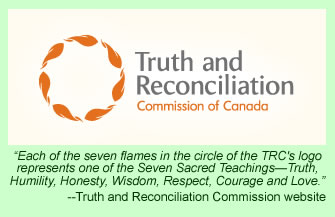Canada’s Truth and Reconciliation Commission issued a summary of its final report last week, which urged Canadians to find ways of reconciling with indigenous people who were harmed by their forced attendance at residential schools. News accounts of the unveiling of the long-anticipated report emphasized that the 94 points in the summary represent the start of a healing process for many Inuit individuals and communities.
 The TRC report summarizes testimonies it received from over 6,000 First Nation, Metis, and Inuit survivors of residential schools, people who described their suffering from the emotional and mental abuse, physical and sexual harm, and deprivation and discrimination they had received while in the schools. Justice Murray Sinclair, Chair of the commission, said that the report makes 94 recommendations for governments at all levels to take action. He urged Canadians to accept them and to find ways of reconciling with the people affected by the abuses.
The TRC report summarizes testimonies it received from over 6,000 First Nation, Metis, and Inuit survivors of residential schools, people who described their suffering from the emotional and mental abuse, physical and sexual harm, and deprivation and discrimination they had received while in the schools. Justice Murray Sinclair, Chair of the commission, said that the report makes 94 recommendations for governments at all levels to take action. He urged Canadians to accept them and to find ways of reconciling with the people affected by the abuses.
Inuit leaders were similarly positive. Cathy Towtongie, President of Nunavut Tunngavik, Inc., an organization that advocates for the Inuit, said, according to one news report, “it is of vital importance that Justice Sinclair’s report, which details the horrible realities of residential school[s], becomes part of the conversation in all Canadian households.”
She urged Canadians to learn about the abuses that occurred in the institutions, “in order to better understand the lasting impacts and legacy that residential schools continue to have on a large percentage of this country’s Aboriginal population.” She said that Canadians must find ways of working together to heal from the abuses of the past.
The Makivuk Corp., which represents the Inuit of northern Quebec, also welcomed the report by the TRC. The document “opened the flood gate” on the concerns that have disturbed the Nunavimmiut residents who have survived the residential schools. The abuses of the past have been a major factor in producing the violence, unemployment, suicides, and other social dysfunctions, Makivik indicated on June 2.
Makivuk president Jobie Tukkiapik said that it is now time to change from “apology to action.” He was referring to the apology issued by Canadian Prime Minister Stephen Harper in 2008, and said that it was time to start the recovery process. “Let’s do it,” he said.
Not all Canadian Inuit were included in the reconciliation process, however. The Inuit residential schools in Labrador had been established before the province of Newfoundland and Labrador joined Canada in 1949, so Prime Minister Harper’s apology omitted them. Separately, about 1,000 survivors of Inuit residential schools in that province have filed class-action suits against the provincial government, the Moravian Mission, and the International Grenfell Association.
Another news report last week indicates that Terry Audla, president of Inuit Tapiriit Kanatami, an NGO representing over 50,000 Inuit, agrees with Justice Sinclair that the residential schools perpetrated a type of cultural genocide on the indigenous people. “It was atrocious what happened,” he said. He urged people to “work toward national understanding and reconciliation among all Canadians.”
He suggested that the history of the residential school system should be part of the curriculum in all Canadian schools, to ensure that this sort of thing never happens again. He condemned the ways the indigenous children in the residential schools were violently punished, abused from speaking their own languages, and neglected even when they were dying from tuberculosis and other diseases.
News stories three years ago described in some detail the horrors that the Canadian residential schools perpetrated on the indigenous peoples. The full report will be issued later in the year after it has been translated into other languages.